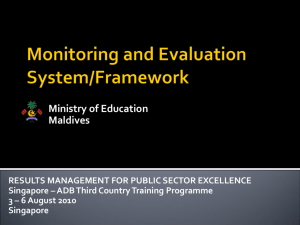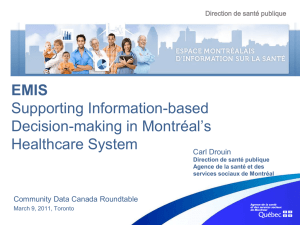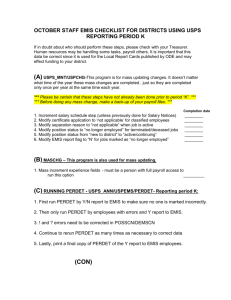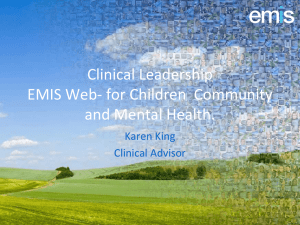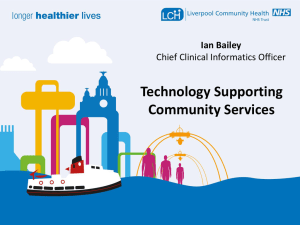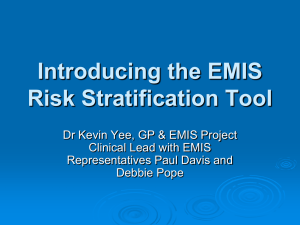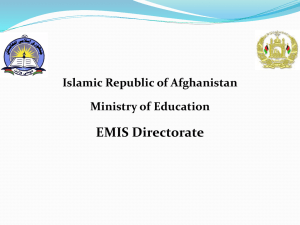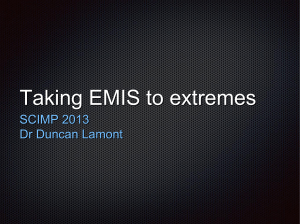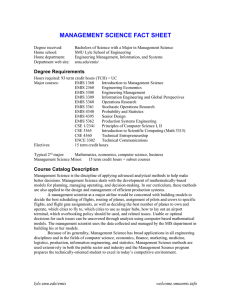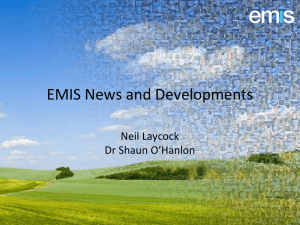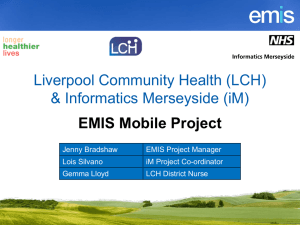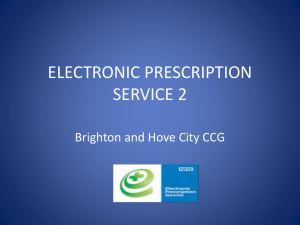Presentation - ICT @ Schools
advertisement
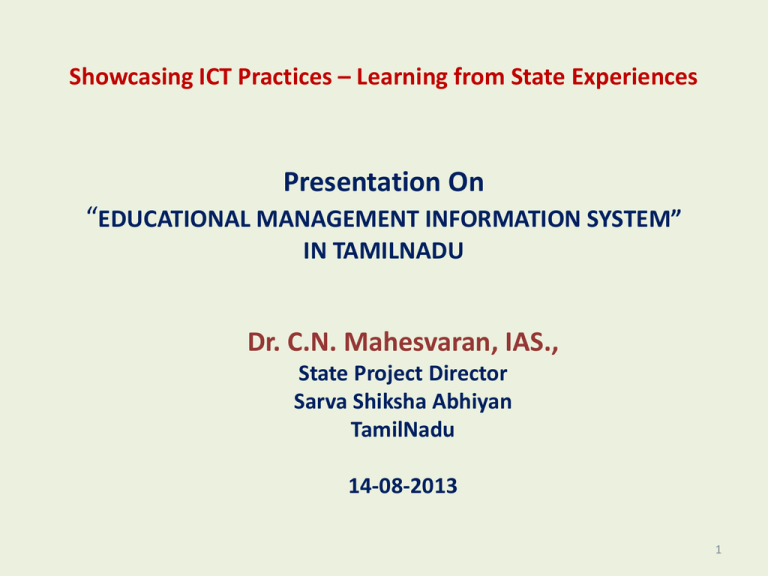
Showcasing ICT Practices – Learning from State Experiences Presentation On “EDUCATIONAL MANAGEMENT INFORMATION SYSTEM” IN TAMILNADU Dr. C.N. Mahesvaran, IAS., State Project Director Sarva Shiksha Abhiyan TamilNadu 14-08-2013 1 PRESENT SCENARIO 2 Revenue Districts 32 Education Districts 66 Education Blocks 413 Educationally Backward Blocks 44 STATE PROFILE Area : 1.30 lakh Sq.km : 32 Corporations : 10 Municipalities : 126 Community Development Blocks : 385 Village Panchayats : 12,524 Habitations (including urban) : 95,010 Revenue Districts (SSA-30) SCHOOLS S. No School type Govt. / Local body Private Aided Self finance (incl. Matriculation Schools) Total 1 Primary Schools 23815 5066 6304 35184 2 Middle Schools 7307 1549 946 9802 3 High Schools 3096 640 1868 5604 4 Higher Secondary Schools 2595 1141 2247 5983 36813 8395 11365 56,573 Total Source: U-DISE 2012 TEACHERS S. No School type Govt. / Local body Private Aided Self finance (incl. Matriculation Schools) Total 1 Primary Schools 60941 23956 52251 137148 2 Middle Schools 49778 15547 12557 77882 3 High Schools 56131 28596 100168 184895 4 Higher Secondary Schools 47679 27153 88887 163719 214529 95252 253863 5,63,644 Total Source: U-DISE 2012 STUDENTS S. No School type Govt. / Local body Private Aided Self finance (incl. Matriculation Schools) Total 1 Primary Schools 1510111 791550 844410 3146071 2 Middle Schools 1272303 525152 260535 2057990 3 High Schools 720167 282222 914140 1916529 4 Higher Secondary Schools 2184441 1608851 2607122 6400414 Total 5687022 3207775 4626207 1,35,21,004 Source: U-DISE 2012 Organizational structure Directorate of School Education Directorate of Elementary Education Directorate of Matriculation Schools Directorates State Council for Educational, Research and Training Directorate of Government Examination Directorate of Public Libraries Directorate of Non Formal and Adult Education Secretary School Education Project / Society Corporation / Board Rashtriya Madhyamik Shiksha Abhiyan Sarva Shiksha Abhiyan Teachers Recruitment Board Tamil Nadu Textbook Corporation School Education Department – Highest Budget Allocation in the State Rs. In Crores Rs. In Crores Welfare Schemes Scheme Standard Beneficiaries Cost (Rs. In crores) (in lakhs) Text books I - XII 92.28 257.41 Note books I–X 81.02 102.69 School bag I – XII 92.28 127.78 Uniform (4 sets) I – VIII 47.07 329.88 Footwear I–X 78.82 104.15 Bus pass I – XII 14.02 320.00 Colour pencil/Crayons I–V 31.00 5.17 Geometry Box VI – X 46.00 16.37 Atlas VI – X 46.00 13.57 XII 5.35 898.00 X – XII 21.52 353.56 Laptops Spl.Cash Incentive PRESENT SYSTEM • Manual collection of data from the schools • Manual maintenance of records of schools, students, teachers • Manual Consolidation • Multiple Data handling • Communication through postal department / email 11 SHORTFALL IN PRESENT SYSTEM • Accuracy of data regarding schools, teachers, and students not authentic • Delay in communication(intra and inter department • Ineffective reporting mechanism • No effective system in place for tracking children both in school and out of school • lack of effective monitoring of the schemes announced by the Government • wastage of time in repeated data collection often resulting in duplication of data • lack of integration with UDISE and AADHAR MEASURE TO CURB SHORTFALL • The above defects lead to a study to identify a suitable methodology • In house study was taken up in coordination with the research division of Anna University namely, AU-KBC Research Centre • Many rounds of meetings were held with all the Directorates by Anna University • THE OUTCOME OF THE STUDY……… EDUCATIONAL MANAGEMENT INFORMATION SYSTEM (EMIS) - 14 Evolution of Educational Management Information System (EMIS) The Hon’ble Chief Minister announced creating of an Educational Management Information System (EMIS) and the same came to existence in the academic year 201213 A pilot was taken up in five schools in Tiruchirapalli District It is proposed to scale up the same to all the schools in 2013-2014. 15 Hon’ble Chief Minister inaugurated the Educational Management Information System on 05.09.2012 16 EMIS - COMPONENTS 17 EMIS – COMPONENTS Web Portal • www.tnschools.gov.in • State Education Portal Database portal • www.emis.tnschools.gov.in • Database of all Schools, Students, teachers and officers Intra Department communication • www.admin.tnschools.gov.in/communication/ • Vertical and Horizontal communication • Linking with other departments E – Content Server • www.ecs.tnschools.gov.in/ • All educational contents to students, teachers 18 19 20 21 22 EMIS - FEATURES 23 EMIS - FEATURES • Single Point Entry for State School Education Department • Unified, integrated, assimilated data of Schools, students, teachers from U-DISE, Aadhar, etc.. • Extensive Reporting Mechanism • Monitoring of teacher attendance • Smart Card for students with unique ID number integrated with AADHAR • Education content server provides textbooks, interactive videos, learning materials outside of the textbooks • Facilitates intra departmental communication 24 State EMIS Cell • A well equipped IT-cell has been established with – 6 Hi-End Servers – of 64 GB RAM 16 core dual processor (Xeon) Capacity of HDD - 2 TB – 15 computers, – State of art infrastructure facilities – well furnished Conference room. • 8 Technical persons (System Analysts and Programmers) and 3 Data Entry Operators from the districts were selected and trained to run the EMIS cell • The Data Entry Operators at the field level have been trained to upload the data in to the EMIS 25 FORMATS • Formats were devised for capturing the required data with respect to – Schools – Teachers – Students 26 FORMAT – SCHOOL PROFILE – SNAPSHOT FORMAT – TEACHER PROFILE – SNAPSHOT FORMAT – STUDENT PROFILE – SNAPSHOT Work done so far • Out of 56573 schools the details of 56336 schools have been uploaded • For 5.5 lakhs teachers the details of 3.2 lakhs have been uploaded • For 1.35 crores students the details of 1.17 crores students have been uploaded 30 EMIS - OUTCOME 31 OUTCOME - DEPARTMENT • Quick Reporting Mechanism resulting better planning • Reduce the duplication of work • Good communication between various stakeholders viz Government, officials, teachers, students, parents and society • Data migration, analysis, mining from macro to micro level 32 OUTCOME - Schools • Reporting Mechanism resulting better planning • Reduce the maintenance of cumbersome registers • Reduce the burden of work in teachers • Assisting in teaching with ECS 33 OUTCOME - Students • Tracking of student from birth to 12th standard • Monitors admissions, attendance and performance of the student • Getting benefit on time • Enriched and flourished education contents to enhances child’s knowledge, potentiality and talent 34 OUTCOME - Teachers • Maintenance of Service Registers • SMS based Monitoring to improve the quality • Timely getting benefits viz. salary, increments, leave • Enhances the quality of teaching using ECS 35 Thank You 36
